Prediction Models of ≥2 MeV Electron Daily Fluences for 3 Days at GEO Orbit Using a Long Short-Term Memory Network
Abstract
:1. Introduction
2. Materials and Methods
2.1. Data and Processing
2.2. Long Short-Term Memory (LSTM) and the Parameters of the Model
2.3. Model Evaluation
3. Results
3.1. The Selection of the Best Offset Time
3.2. The LSTM Models for Predicting ≥2 MeV Electron Daily Fluences on the Following Day at GEO Orbit
3.2.1. The Development of the LSTM Models
3.2.2. Comparisons with Different Models
3.3. The LSTM Models for Predicting ≥2 MeV Electron Daily Fluences for the Following Second or Third Day at GEO Orbit
4. Discussion
5. Conclusions
Author Contributions
Funding
Data Availability Statement
Acknowledgments
Conflicts of Interest
References
- Horne, R. Space weather impacts on satellites and forecasting the Earth’s electron radiation belts with SPACECAST. Space Weather 2013, 11, 169–186. [Google Scholar] [CrossRef]
- Lai, S. Deep dielectric charging and spacecraft anomalies. In Extreme Events in Geospace; Elsevier: Amsterdam, The Netherlands, 2018; pp. 419–432. [Google Scholar]
- Pilipenko, V. Statistical relationships between satellite anomalies at geostationary orbit and high-energy particles. Adv. Space Res. 2006, 37, 1192–1205. [Google Scholar] [CrossRef]
- Reagan, J. Space charging currents and their effects on spacecraft systems. IEEE Trans. Electr. Insul. 1983, El-18, 354–365. [Google Scholar] [CrossRef]
- Baker, D. Highly relativistic magnetospheric electrons: A role in coupling g to the middle atmosphere. Geophys. Res. Lett. 1987, 14, 1027. [Google Scholar] [CrossRef]
- Violet, M. Spacecraft anomalies on the CRRES satellite correlated with the environment and insulator samples. IEEE Trans. Nucl. Sci. 1993, 40, 1512–1520. [Google Scholar] [CrossRef]
- Lanzerotti, L. Studies of spacecraft charging on a geosynchronous telecommunications satellite. Adv. Space Res. 1998, 22, 79–82. [Google Scholar] [CrossRef]
- Koons, H. The Impact of the Space Environment on Space Systems. In Proceedings of the 6th Spacecraft Charging Conference, AFRL Science Center USA, Hanscom, MA, USA, 2–6 November 1998. [Google Scholar]
- Wrenn, G. A solar cycle of spacecraft anomalies due to internal charging. Ann. Geophys. 2002, 20, 953–956. [Google Scholar] [CrossRef]
- Lucci, N. Space weather conditions and spacecraft anomalies in different orbits. Space Weather 2013, 3, 1–16. [Google Scholar]
- Lohmeyer, W. Response of geostationary communications satellite solidstate power amplifiers to high-energy electron fluence. Space Weather 2015, 13, 298–315. [Google Scholar] [CrossRef]
- Li, X. Quantitative prediction of radiation belt electrons at geostationary orbit based on solar wind measurements. Geophys. Res. Lett. 2001, 28, 1887–1890. [Google Scholar] [CrossRef]
- Li, X. Variations of 0.7–6.0 MeV electrons at geosynchronous orbit as a function of solar wind. Space Weather 2004, 2. [Google Scholar] [CrossRef]
- Li, X. Correlation between the inner edge of outer radiation belt electrons and the innermost plasmapause location. Geophys. Res. Lett. 2006, 33, 14107. [Google Scholar] [CrossRef]
- Li, X. Behavior of MeV electrons at geosynchronous orbit during last two solar cycles. J. Geophys. Res. 2011, 116. [Google Scholar] [CrossRef]
- Baker, D. Deep dielectric charging effects due to high energy electrons in the earth’s outer magnetosphere. J. Electrost. 1987, 20, 3–19. [Google Scholar] [CrossRef]
- Baker, D. Linear prediction filter analysis of relativistic electron properties at 6.6RE. J. Geophys. Res. 1990, 95, 15133–15140. [Google Scholar] [CrossRef]
- Turner, D. Quantitative forecast of relativistic electron flux at geosynchronous orbit based on low-energy electron flux. Space Weather 2008, 6. [Google Scholar] [CrossRef]
- Rigler, E. Adaptive linear prediction of radiation belt electrons using the Kalman fillter. Space Weather 2004, 2, S03003. [Google Scholar] [CrossRef]
- Ukhorskiy, A. Data-derived forecasting model for relativistic electron intensity at geosynchronous orbit. Geophys. Res. Lett. 2004, 31. [Google Scholar] [CrossRef]
- Boynton, R. Online NARMAX model for electron fluxes at GEO. Ann. Geophys. 2015, 33, 405–411. [Google Scholar] [CrossRef]
- Lam, H. Prediction of relativistic electron fluence using magnetic observatory data. COSPAR Colloq. Ser. 2002, 14, 439–442. [Google Scholar]
- Kataoka, R. Flux enhancement of radiation belt electrons during geomagnetic storms driven by coronal mass ejections and corotating interaction regions. Space Weather 2006, 4. [Google Scholar] [CrossRef]
- Miyoshi, Y. Probabilistic space weather forecast of the relativistic electron flux enhancement at geosynchronous orbit. J. Atmos.-Sol.-Terr. Phys. 2008, 70, 475–481. [Google Scholar] [CrossRef]
- He, T. Quantitative prediction of relativistic electron flux at geosynchronous orbit with geomagnetic pulsations parameters. Chin. J. Space Sci. 2013, 33, 20–27. [Google Scholar] [CrossRef]
- Li, S. Dynamic prediction model of relativistic electron differential fluxes at the geosynchronous orbit. Chin. J. Space Sci. 2017, 37, 298–311. [Google Scholar]
- Potapova, A. Solar cycle variation of “killer” electrons at geosynchronous orbit and electron flux correlation with the solar wind parameters and ULF waves intensity. Acta Astronaut. 2014, 95, 55–63. [Google Scholar] [CrossRef]
- Sakaguchi, K. Relativistic electron flux forecast at geostationary orbit using Kalman filter based on multivariate autoregressive model. Space Weather 2013, 11, 79–89. [Google Scholar] [CrossRef]
- Zhong, Q. Statistical model of the relativistic electron fluence forecast at geostationary orbit. Chin. J. Space Sci. 2019, 39, 18–27. [Google Scholar] [CrossRef]
- Qian, Y. An hourly prediction model of relativistic electrons based on empirical mode decomposition. Space Weather 2020, 17, e2018SW0022078. [Google Scholar] [CrossRef]
- Glauert, S. Evaluation of SaRIF High-Energy Electron Reconstructions and Forecasts. Space Weather 2021, 19, 22. [Google Scholar] [CrossRef]
- Koon, H. A neural network model of the relativistic electron flux at geosynchronous orbit. J. Geophys. Res. 1991, 96, 5549–5559. [Google Scholar] [CrossRef]
- Fukata, M. Neural network prediction of relativistic electrons at geosynchronous orbit during the storm recovery phase: Effects of recurring substorms. Ann. Geophys. 2002, 20, 947–951. [Google Scholar] [CrossRef]
- Xue, B. Forcast of the enhancement of relativistic eletron at the GEO-synchronous orbit. Chin. J. Space Sci. 2004, 24, 283–288. [Google Scholar]
- Guo, C. Approach for predicting the energetic electron flux in geosynchronous earth orbit. Chin. J. Space Sci. 2013, 33, 418–426. [Google Scholar] [CrossRef]
- Ling, A. A neural network-based geosynchronous relativistic electron flux forecasting model. Space Weather 2010, 8. [Google Scholar] [CrossRef]
- Shin, D. Artificial neural network prediction model for geosynchronous electron fluxes: Dependence on satellite position and particle energy. Space Weather 2016, 14, 313–321. [Google Scholar] [CrossRef]
- Zhang, H. Relativistic electron flux prediction at geosynchronous orbit based on the neural network and the quantile regression method. Space Weather 2020, 18, e2020SW002445. [Google Scholar] [CrossRef]
- Wang, R. Study on the forecasting method of relativistic electron flux at geostationary orbit based on support vector machine. Chin. J. Space Sci. 2012, 32, 354–361. [Google Scholar] [CrossRef]
- Hinton, G. Deep neural networks for acoustic modeling in speech recognition: The shared views of four research groups. IEEE Signal Process. Mag. 2012, 29, 82–97. [Google Scholar] [CrossRef]
- Krizhevsky, A. Imagenet classification with deep convolutional neural networks. Commun. ACM 2012, 60, 84–90. [Google Scholar] [CrossRef]
- Lecun, Y. Deep learning. Nature 2015, 521, 436–444. [Google Scholar] [CrossRef]
- Hinton, G. Reducing the Dimensionality of Data with Neural Networks. Science 2006, 313, 504–507. [Google Scholar] [CrossRef] [PubMed]
- Wei, L.H. Quantitative prediction of high-energy electron integral flux at geostationary orbit based on deep learning. Space Weather 2018, 16, 903–916. [Google Scholar] [CrossRef]
- Onsager, T. The radial gradient of relativistic electrons at geosynchronous orbit. J. Geophys. Res. 2004, 109, A05221. [Google Scholar] [CrossRef]
- Sun, X. Influence of geomagnetic field structure on ≥2 MeV electron distribution at geostationary orbit. Chin. J. Geophys. 2020, 63, 3604–3625. [Google Scholar]
- Sun, X. Modeling the relationship of ≥2 MeV electron fluxes at different longitudes in geostationary orbit by the machine learning method. Remote Sens. 2021, 13, 3347. [Google Scholar] [CrossRef]
- Ohno, M. Geomagnetic poles over the past 10000 years. Geophys. Res. Lett. 1992, 19, 1715–1718. [Google Scholar] [CrossRef]
- Korte, M. Magnetic poles and dipole tilt variation in recent decades to millennia. Earth Planet 2008, 60, 937–948. [Google Scholar] [CrossRef]
- Meredith, N. Extreme relativistic electron fluxes at geosynchronous orbit: Analysis of goes e ≥2 mev electrons. Earth Planet 2015, 13, 170–184. [Google Scholar] [CrossRef]
- Lin, R. A three-dimensional asymmetric magnetopause model. J. Geophys. Res. 2010, 115, A04207. [Google Scholar] [CrossRef]
- Graves, A. Supervised Sequence Labeling with Recurrent Neural Networks. Doctoral Dissertation, Technical University of Munich, Munich, Germany, 2008. [Google Scholar]
- Graves, A. Framewise phoneme classification with bidirectional LSTM and other neural network architectures. Neural Netw. 2005, 18, 602. [Google Scholar] [CrossRef]
- Vinyals, O. Show and tell: A neural image caption generator. In Proceedings of the 2015 IEEE Conference on Computer Vision and Pattern Recognition (CVPR), Boston, MA, USA, 7–12 June 2015; pp. 3156–3164. [Google Scholar]
- Greff, K. LSTM: A search space odyssey. IEEE Trans. Neural Netw. Learn. Syst. 2016, 99, 1–11. [Google Scholar] [CrossRef] [PubMed]
- Hochreiter, S. Long short-term memory. Neural Comput. 1997, 9, 1735–1780. [Google Scholar] [CrossRef] [PubMed]
- Werbos, P. Backpropagation through time: What it does and how to do it. Proc. IEEE 1990, 78, 1550–1560. [Google Scholar] [CrossRef]
- Bengio, Y. Learning long-term dependencies with gradient descent is difficult. IEEE Trans. Neural Netw. 1994, 5, 157–166. [Google Scholar] [CrossRef]
- Sofiyanti, N. Understanding LSTM Networks. GITHUB Colah Blog 2015, 22, 137–141. [Google Scholar]
- Chung, J. Empirical evaluation of gated recurrent neural networks on sequence modeling. arXiv 2014, arXiv:1412.3555. [Google Scholar]
- He, X. Solar Flare Short-term Forecast Model Based on Long and Short-term Memory Neural Network. Chin. Astron. Astrophys. 2023, 47, 108–126. [Google Scholar]
- Yu, K. Deep learning: Yesterday, today, and tomorrow. J. Comput. Res. Dev. 2013, 20, 1349. [Google Scholar]
- Cai, M. Maxout neurons for deep convolutional and LSTM neural networks in speech recognition. Speech Commun. 2016, 77, 53–64. [Google Scholar] [CrossRef]
- Kingma, D. Adam: A method for stochastic optimization. arXiv 2015, arXiv:1412.6980. [Google Scholar]
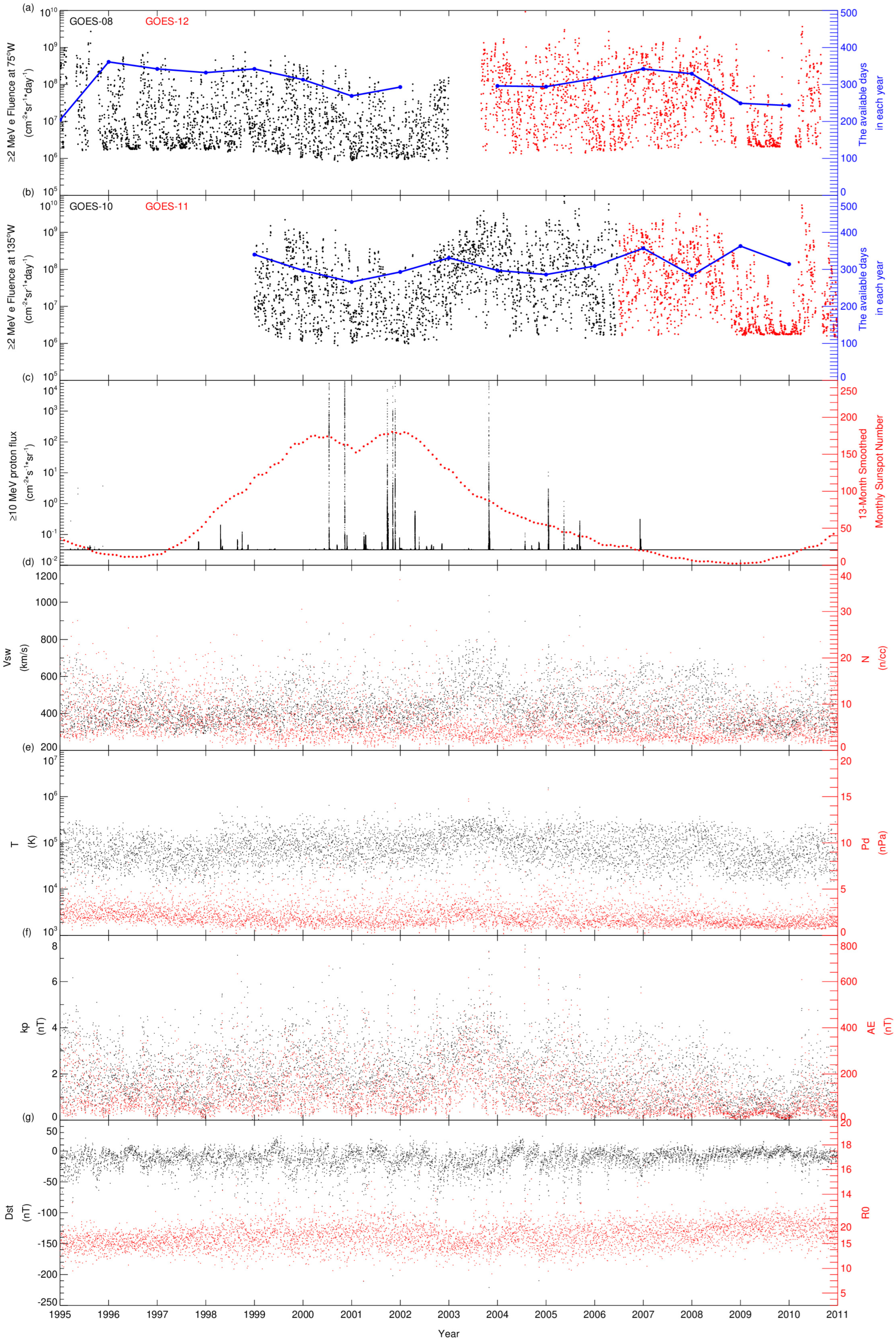

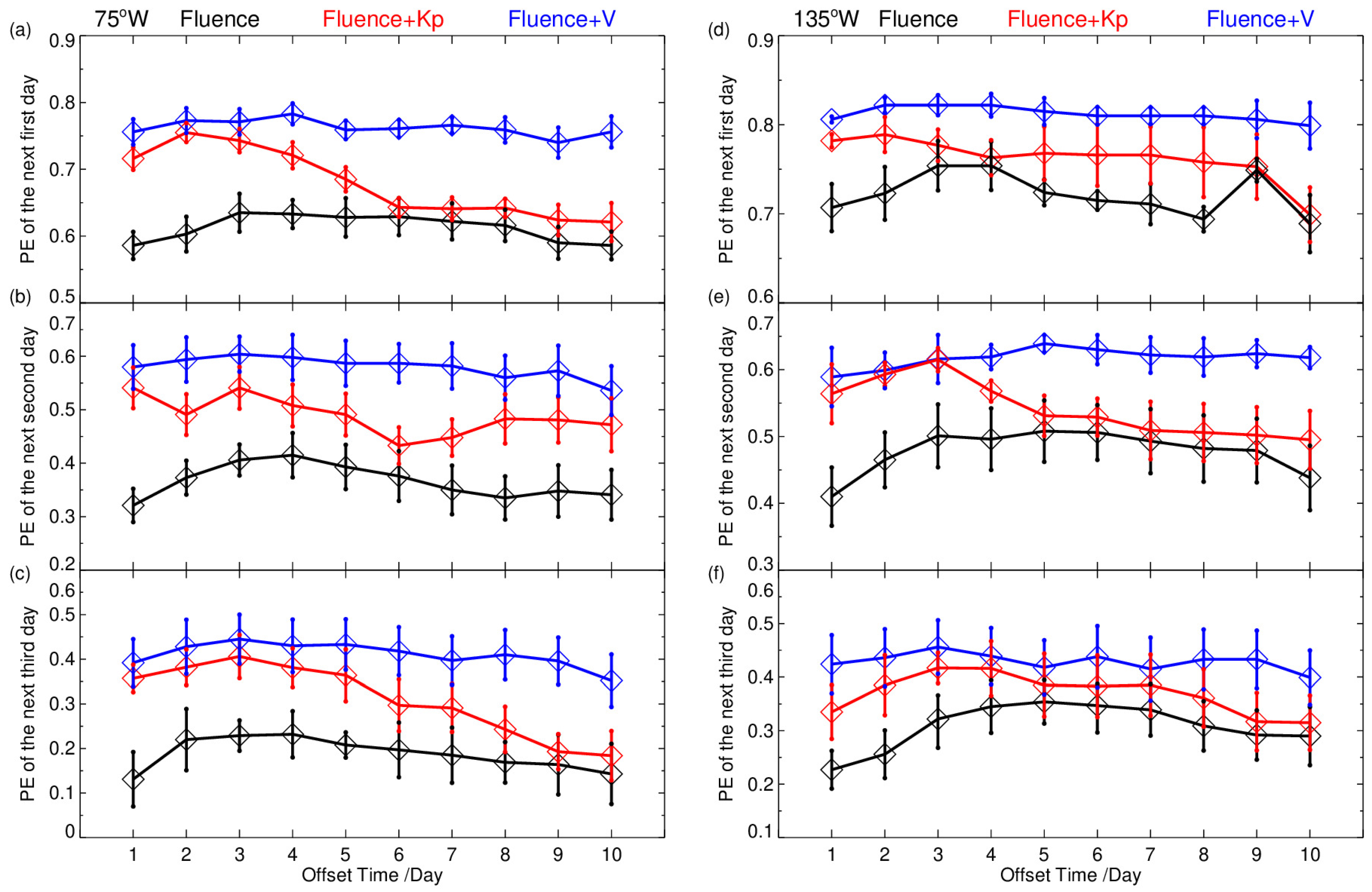


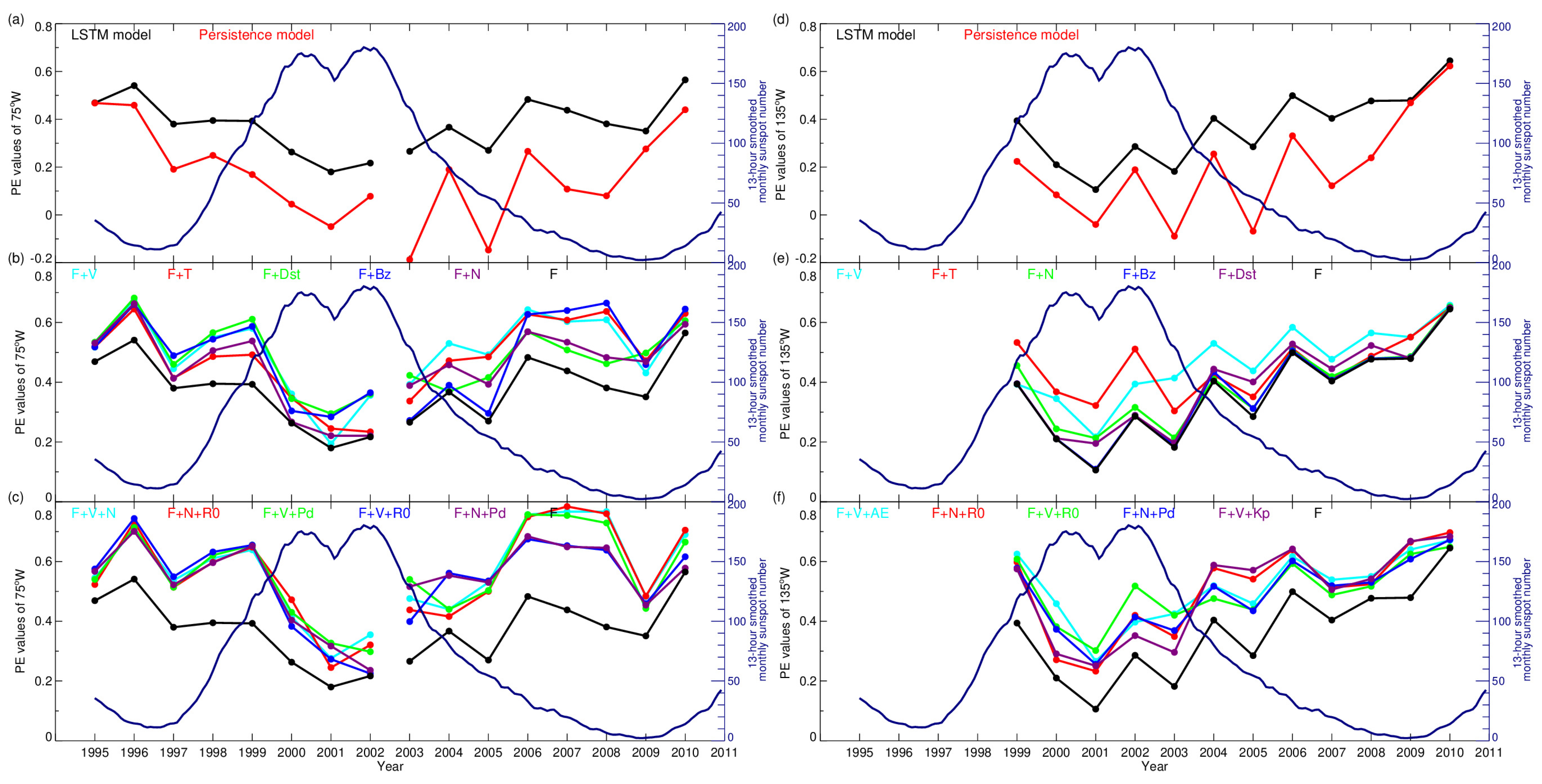
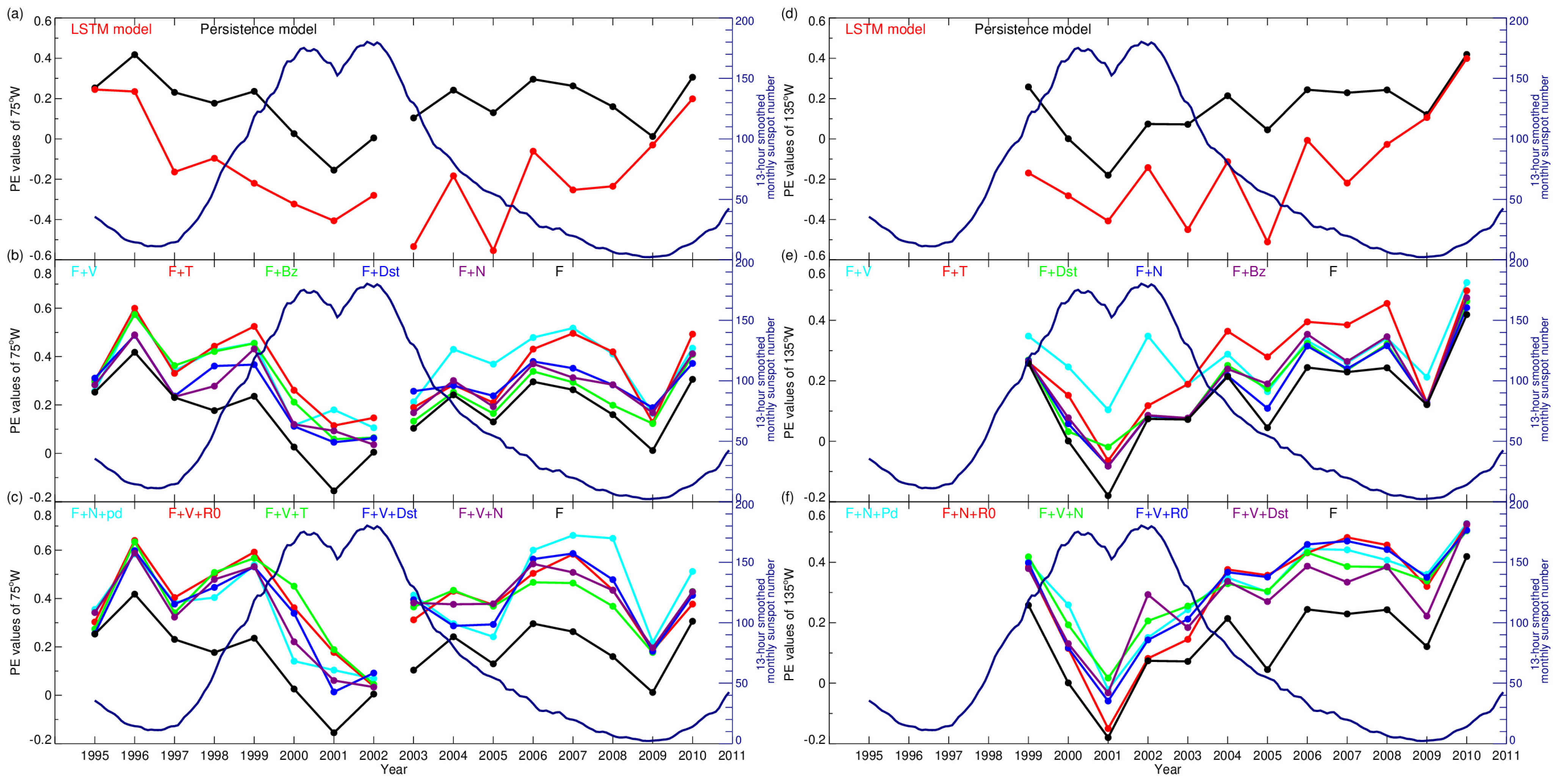

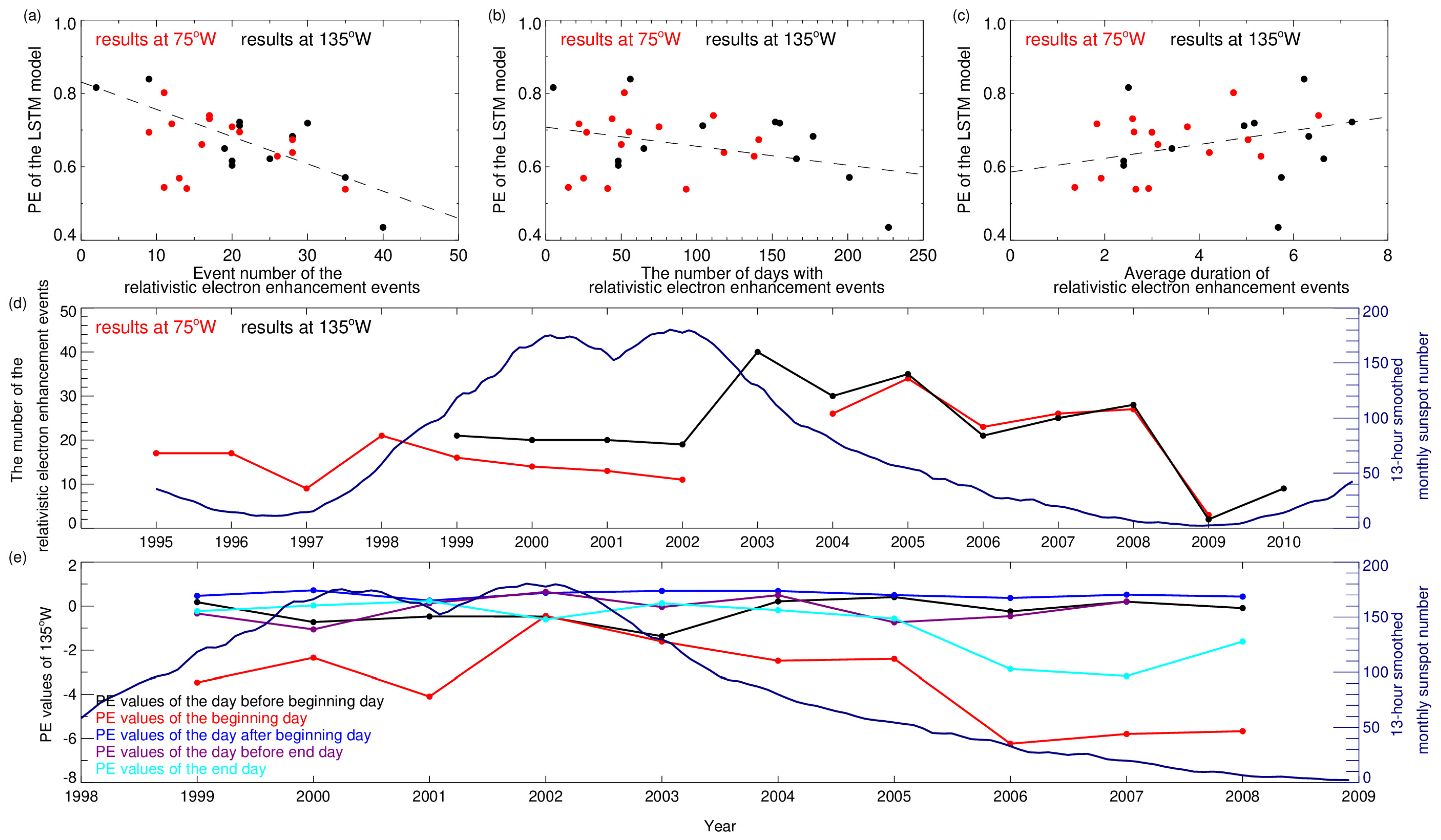
| Longitude | Year | The Combinations of Different Parameters | PE of LSTM Model with Different Combinations |
|---|---|---|---|
| 75°W | 1995–2010.08 | F + Vsw | 0.771 |
| F + Kp | 0.769 | ||
| F + N | 0.765 | ||
| F + T | 0.764 | ||
| F + AE | 0.758 | ||
| 135°W | 1999–2010 | F + Vsw | 0.790 |
| F + Kp | 0.784 | ||
| F + T | 0.780 | ||
| F + R0 | 0.779 | ||
| F + Pd | 0.778 | ||
| 75°W | 1995–2010.08 | F + Vsw + Kp | 0.801 |
| F + N + Kp | 0.801 | ||
| F + Vsw + AE | 0.799 | ||
| F + T + Kp | 0.795 | ||
| F + N + AE | 0.792 | ||
| 135°W | 1999–2010 | F + Vsw + Kp | 0.819 |
| F + Vsw + AE | 0.818 | ||
| F + N + AE | 0.815 | ||
| F + T + Kp | 0.811 | ||
| F + N + Kp | 0.810 |
| Model/Year | The Sunspot Number | LSTM Model for 75°W (135°W) | SVM Model by Wang et al. (2012) [39] | RBF Model by Guo et al. (2013) [35] | Geomagnetic Pulsation Model by He et al., 2013) [25] | Empirical Orthogonal Function Model by Li et al., 2017) [26] | LSTM Model by Wei et al. (2018) [44] | EMD Model by Qian et al., 2020) [30] |
|---|---|---|---|---|---|---|---|---|
| F + Vsw + Kp | A Total of Five Parameters | F + Vsw + ap | F + Pi12 + Pc5 | A Total of Eight Parameters | F + Vsw + Kp or F + R0 + Kp | A Total of Ten Parameters | ||
| 1995 | 24.78 | 0.769 | ||||||
| 1996 | 12.56 | 0.827 | ||||||
| 1997 | 30.50 | 0.743 | ||||||
| 1998 | 85.79 | 0.785 | ||||||
| 1999 | 139.67 | 0.790 (0.812) | ||||||
| 2000 | 169.89 | 0.607 (0.589) | ||||||
| 2001 | 168.28 | 0.606 (0.586) | 0.730 | |||||
| 2002 | 160.48 | 0.646 (0.705) | 0.670 | 0.810 | ||||
| 2003 | 102.95 | 0.777 (0.678) | 0.730 | 0.613 | 0.780 | |||
| 2004 | 66.29 | 0.790 (0.816) | 0.620 | 0.673 | 0.810 | |||
| 2005 | 44.83 | 0.765 (0.787) | 0.720 | 0.664 | 0.790 | |||
| 2006 | 26.05 | 0.859 (0.840) | 0.762 | 0.830 | ||||
| 2007 | 13.18 | 0.848 (0.779) | ||||||
| 2008 | 4.21 | 0.837 (0.806) | 0.710 | 0.776 | 0.833 | |||
| 2009 | 6.39 | 0.759 (0.886) | 0.808 | 0.896 | ||||
| 2010 | 26.19 | 0.833 (0.891) | 0.882 | 0.911 | ||||
| 1995–2010 (1999–2010) | 67.62 | 0.801 (0.819) |
| Prediction | Longitude | Year | The Combinations of Different Parameters | PE of LSTM Model with Different Combinations |
|---|---|---|---|---|
| For the second day | 75°W | 1995–2010.08 | F + Vsw | 0.605 |
| F + T | 0.586 | |||
| F + Dst | 0.580 | |||
| F + Bz | 0.573 | |||
| F + N | 0.550 | |||
| 135°W | 1999–2010 | F + Vsw | 0.608 | |
| F + T | 0.594 | |||
| F + N | 0.543 | |||
| F + Bz | 0.530 | |||
| F + Dst | 0.528 | |||
| For the third day | 75°W | 1995–2010.08 | F + Vsw | 0.461 |
| F + T | 0.454 | |||
| F + Bz | 0.410 | |||
| F + Dst | 0.406 | |||
| F + N | 0.401 | |||
| 135°W | 1999–2010 | F + Vsw | 0.475 | |
| F + T | 0.467 | |||
| F + Dst | 0.397 | |||
| F + N | 0.391 | |||
| F + Bz | 0.387 | |||
| For the second day | 75°W | 1995–2010.08 | F + Vsw + N | 0.658 |
| F + N + R0 | 0.651 | |||
| F + Vsw + Pd | 0.649 | |||
| F + Vsw + R0 | 0.638 | |||
| F + N + Pd | 0.632 | |||
| 135°W | 1999–2010 | F + Vsw + AE | 0.643 | |
| F + N + R0 | 0.637 | |||
| F + Vsw + R0 | 0.632 | |||
| F + N + Pd | 0.626 | |||
| F + Vsw + Kp | 0.619 | |||
| For the third day | 75°W | 1995–2010.08 | F + N + Pd | 0.523 |
| F + Vsw + R0 | 0.514 | |||
| F + Vsw + T | 0.507 | |||
| F + Vsw + Dst | 0.505 | |||
| F + Vsw + N | 0.504 | |||
| 135°W | 1999–2010 | F + N + Pd | 0.508 | |
| F + N + R0 | 0.504 | |||
| F + Vsw + N | 0.501 | |||
| F + Vsw + R0 | 0.485 | |||
| F + Vsw + Dst | 0.483 |
Disclaimer/Publisher’s Note: The statements, opinions and data contained in all publications are solely those of the individual author(s) and contributor(s) and not of MDPI and/or the editor(s). MDPI and/or the editor(s) disclaim responsibility for any injury to people or property resulting from any ideas, methods, instructions or products referred to in the content. |
© 2023 by the authors. Licensee MDPI, Basel, Switzerland. This article is an open access article distributed under the terms and conditions of the Creative Commons Attribution (CC BY) license (https://creativecommons.org/licenses/by/4.0/).
Share and Cite
Sun, X.; Lin, R.; Liu, S.; Luo, B.; Shi, L.; Zhong, Q.; Luo, X.; Gong, J.; Li, M. Prediction Models of ≥2 MeV Electron Daily Fluences for 3 Days at GEO Orbit Using a Long Short-Term Memory Network. Remote Sens. 2023, 15, 2538. https://doi.org/10.3390/rs15102538
Sun X, Lin R, Liu S, Luo B, Shi L, Zhong Q, Luo X, Gong J, Li M. Prediction Models of ≥2 MeV Electron Daily Fluences for 3 Days at GEO Orbit Using a Long Short-Term Memory Network. Remote Sensing. 2023; 15(10):2538. https://doi.org/10.3390/rs15102538
Chicago/Turabian StyleSun, Xiaojing, Ruilin Lin, Siqing Liu, Bingxian Luo, Liqin Shi, Qiuzhen Zhong, Xi Luo, Jiancun Gong, and Ming Li. 2023. "Prediction Models of ≥2 MeV Electron Daily Fluences for 3 Days at GEO Orbit Using a Long Short-Term Memory Network" Remote Sensing 15, no. 10: 2538. https://doi.org/10.3390/rs15102538
APA StyleSun, X., Lin, R., Liu, S., Luo, B., Shi, L., Zhong, Q., Luo, X., Gong, J., & Li, M. (2023). Prediction Models of ≥2 MeV Electron Daily Fluences for 3 Days at GEO Orbit Using a Long Short-Term Memory Network. Remote Sensing, 15(10), 2538. https://doi.org/10.3390/rs15102538






